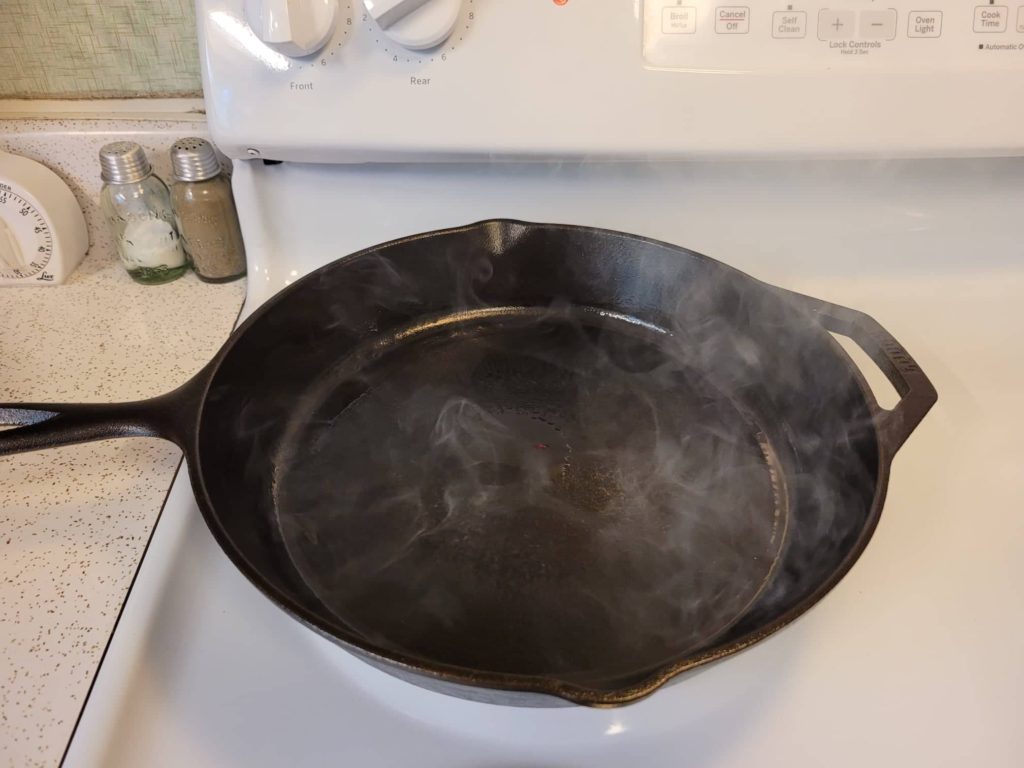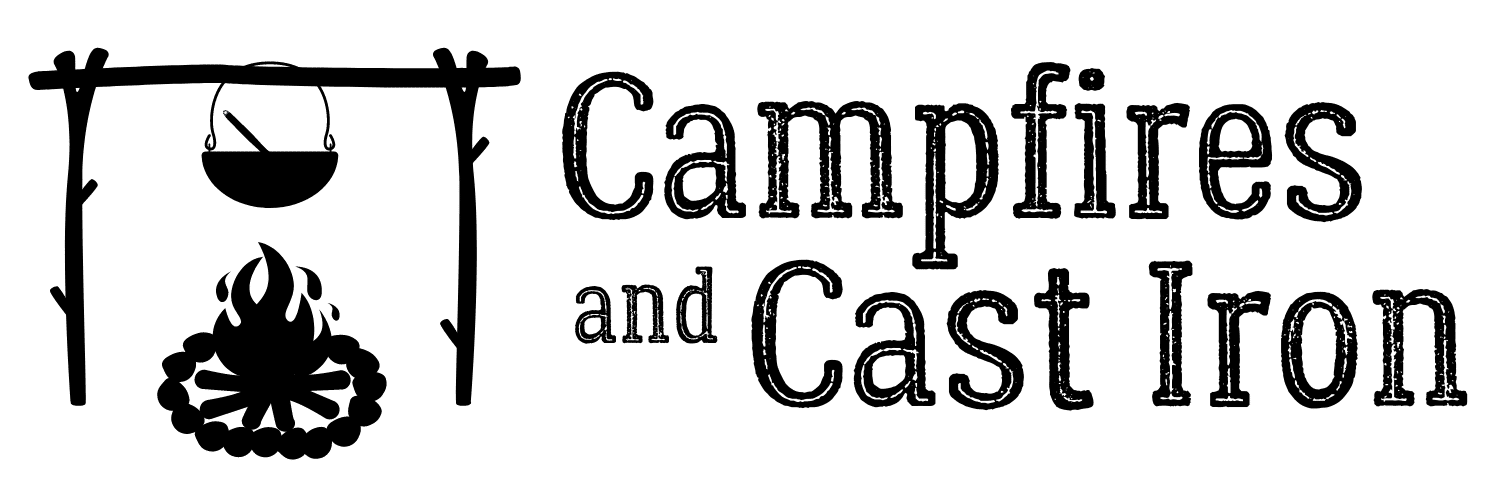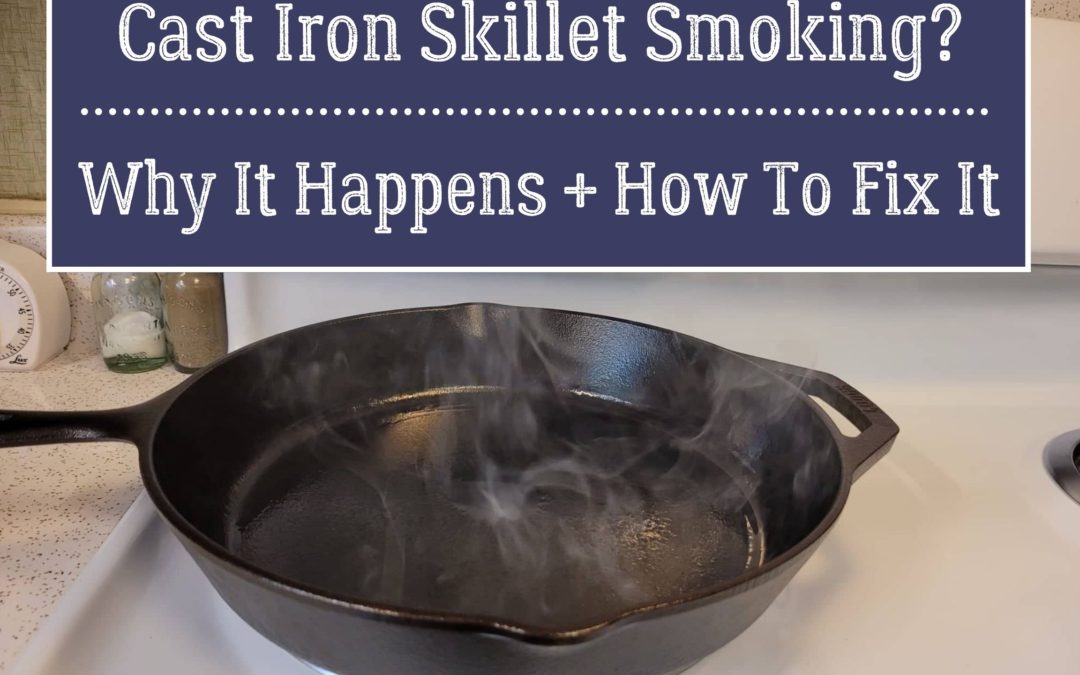Last updated on August 24th, 2022
If you’ve ever cooked with cast iron, you’ve probably encountered the issue of your skillet smoking while pre-heating, searing meat, or cooking on a stovetop burner. Nobody enjoys a smoky kitchen or the taste of bitter, burned flavors in their food. So why is your cast iron skillet smoking, and how do you prevent it?
Cast iron skillets smoke when heated excessively, when food is cooked at too high a temperature, or when cooking oil is heated above its smoke point. To prevent smoking, use a cooking oil with an appropriate temperature rating in a clean, well-seasoned cast iron skillet over no more than medium-high heat.
It really is quite simple to avoid accidentally causing your cast iron skillet to smoke, even when using higher temperatures to sear meat. With a little knowledge of how cast iron conducts heat and an understanding of cooking oil smoke points, you’ll be well on your way to flavorful cooking without the smoke.
Why Is My Cast Iron Skillet Smoking?
Let’s look at the reasons a cast iron skillet might produce smoke. Then, I’ll show you what to do with a skillet that’s starting to smoke while you’re cooking, followed by easy ways to prevent this problem from happening again.

Cooking With A Dirty Pan
If your cast iron pan is dusty, rusty, or has leftover bits of food or used cooking oil in it, these things can burn when the skillet is heated and cause smoking. Always make sure to begin with a clean, well-seasoned pan.
Improperly Seasoned Cast Iron
When a cast iron skillet is properly seasoned, the cooking surface is smooth and dry thanks to a hard layer of polymerized oil. If the seasoning layer didn’t form correctly due to using too much oil, the wrong type of oil, or not heating the pan to a high enough temperature during the seasoning process, there may be liquid oil left in the crevices of the iron. This residual oil can begin to smoke when the skillet is pre-heated or cooked with at higher temperatures.
Overheating The Pan
This is probably the most common reason cast iron skillets produce smoke. This is also why it is important to understand how the properties of cast iron differ from those of other metals used to make cookware, such as aluminum, copper, and stainless steel.
By nature, cast iron is not an efficient conductor of heat. It takes longer to heat up than other metals. But, once it heats up, cast iron retains heat extremely well.
While cooking, most types of metal pans don’t retain heat as efficiently as cast iron and are therefore continuously losing a greater amount of heat to the surrounding air. This allows the pan’s temperature to stay within a more accurately controlled range. Additionally, if an aluminum or stainless steel pan becomes too hot, turning down the burner temperature will allow these types of pans to cool fairly quickly.
However, this is not the case with cast iron pans. Because cast iron retains heat so well and doesn’t dissipate it to the surrounding air very quickly, the heat continues to build up and can cause the pan to get much hotter than intended. Even if you turn down the burner, it will take a long time for the cast iron to cool down. As a result, smoke is produced when oils, fats, and food are heated beyond their smoke points and begin to burn.
Using The Wrong Oil For The Cooking Method
Oil type and cooking temperature go hand-in-hand when using cast iron pans. As mentioned above, if a cooking oil or fat is heated beyond its smoke point, it will burn and produce smoke. This is why it’s important to be familiar with the smoke points of common cooking oils and know which oils or fats are appropriate to use for various cooking methods.
Continue reading below for more information on cooking oils, smoke points, and how to choose the right oil for specific cooking methods.
What To Do If Your Skillet Starts Smoking
If your cast iron skillet starts smoking while cooking, simply follow these instructions:
- Remove the skillet from the burner using heat-resistant gloves or pot holders to protect your hands.
- Place the skillet on a cooling rack or an unused stovetop burner to allow the pan to cool for a few minutes. Turn on a kitchen exhaust fan or open a window to ventilate the smoke, if needed.
- Turn down the heat and allow the burner you’re using to cool for a minute or two.
- Once the skillet has stopped smoking and the burner is set to a lower heat, place the pan back on the burner and resume cooking.
Remember that cast iron heats up slowly but then retains heat very well, often causing it to continue heating while cooking. You may need to intermittently turn down the burner setting as you cook to prevent the skillet from overheating.
How To Prevent Cast Iron Pans From Smoking
Now that you know what causes cast iron cookware to smoke and what steps to take if it starts smoking, let’s look at the best ways to prevent cast iron pans from smoking while you’re cooking.
Cook With A Clean Pan
Always make sure your cast iron pan is clean prior to using it by following these steps:
- If any crumbs, leftover cooking oil, or grease are left in the skillet, wipe them out.
- Rinse the pan with water and lightly scrub it using a non-abrasive sponge or dish brush.
- Place the pan on a stovetop burner over medium heat or in the oven at 350°F for 3 to 5 minutes to evaporate any remaining moisture.
- Let the pan cool, then apply a very light coat of canola, grapeseed, or vegetable oil to the cooking surface with a paper towel or lint-free cloth to protect it from rust. Buff excess oil off of the pan with the cloth. This will prevent smoking and stickiness.
Need help seasoning your cast iron skillet? Check out my helpful article, Seasoning Cast Iron Cookware: A Step-By-Step Guide.
Use The Right Type Of Oil For The Cooking Method
Using a cooking oil with a low smoke point is a surefire way to end up with a smoky kitchen while cooking. To prevent this, make sure the type of oil you cook with has a high enough smoke point to handle the heat.
For easy reference, I’ve created a table of the most common cooking oils and fats, their smoke points, and whether or not they are suitable for high-heat cooking such as frying and searing.
Table: Cooking Oils And Smoke Points
| Cooking Oil / Fat | Smoke Point | Suitable For Frying? | Suitable For Searing? |
|---|---|---|---|
| Butter | 275-300°F | No | No |
| Bacon Grease | 325°F | No | No |
| Coconut (unrefined) | 350°F | No | No |
| Olive | 375-400°F | Maybe | No |
| Canola | 400°F | Yes | Yes |
| Coconut (refined) | 400°F | Yes | Yes |
| Grapeseed | 420°F | Yes | Yes |
| Soybean / Vegetable | 450°F | Yes | Yes |
| Peanut | 450°F | Yes | Yes |
| Corn | 450°F | Yes | Yes |
| Sunflower | 450°F | Yes | Yes |
| Ghee (clarified butter) | 450°F | Yes | Yes |
| Avocado (refined) | 520°F | Yes | Yes |
Heat The Skillet Slowly And Avoid Overheating
This is probably the simplest yet most effective way to avoid a smoking cast iron skillet. As mentioned earlier, cast iron cookware retains heat VERY well and often continues to get hotter beyond the intended cooking temperature. These easy steps will help you avoid overheating your cast iron pan.
- Pre-heat cast iron cookware slowly over medium heat. It may take a few extra minutes, but it will be easier to achieve the desired temperature without overshooting the mark.
- For searing meat, it’s okay to pre-heat the skillet over medium-high heat (around burner setting 7 or 8), but don’t automatically jump to burner setting 10 or “HI.” Sear the meat as soon as the pan is hot enough, then quickly turn the temperature down to medium-low. The pan will have retained quite a bit of heat and will be plenty hot to continue cooking.
- Keep an eye on the pan temperature as you cook. Due to excellent heat retention, it’s typical to turn down the heat setting as your food cooks to avoid overheating it.
Cast Iron Smoking While Seasoning Is Normal
If you’re seasoning your cast iron skillet and see or smell a bit of smoke coming from the oven, don’t worry. It’s normal for your pan to produce some light smoke as the oil undergoes the polymerization process needed to form the seasoning layer. Turn on the kitchen ventilation fan or open a window to minimize the smoky smell in the house. Also, don’t forget to check out my complete guide to cast iron seasoning. It’s a super handy reference!
Conclusion
Hopefully, this article has been helpful for understanding what causes a cast iron skillet to smoke and how to prevent it from smoking while cooking.
Be sure to check out my camping recipes and additional cast iron cooking and care guides on the blog. Happy cooking! 🙂
This post may contain affiliate links. This means if you click on a link and make a purchase, I will receive a small commission, at no cost to you, that makes it possible for me to keep the Campfires and Cast Iron site up and running. Please see our disclosure policy for details.


